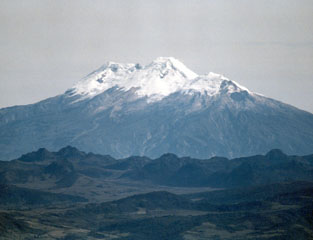Report on Nevado del Huila (Colombia) — 14 February-20 February 2007
Smithsonian Institution / US Geological Survey
Weekly Volcanic Activity Report, 14 February-20 February 2007
Managing Editor: Sally Sennert.
Please cite this report as:
Global Volcanism Program, 2007. Report on Nevado del Huila (Colombia) (Sennert, S, ed.). Weekly Volcanic Activity Report, 14 February-20 February 2007. Smithsonian Institution and US Geological Survey.
Nevado del Huila
Colombia
2.93°N, 76.03°W; summit elev. 5364 m
All times are local (unless otherwise noted)
INGEOMINAS reported increased seismic activity and two explosions from Nevado del Huila on 19 February. An ash plume rose to an altitude of approximately 6 km (19,700 ft) a.s.l. During aerial observations on 20 February, ash deposits were seen on the W sector of a summit glacier and dispersed to the NW. Fumarolic plumes originating from several points along a fissure rose to 7 km (23,000 ft) a.s.l. Small mudflows from a glacier traveled down a gorge. Based on news reports, small avalanches prompted officials to order evacuations from towns bordering rivers.
Geological Summary. Nevado del Huila, the highest peak in the Colombian Andes, is an elongated N-S-trending volcanic chain mantled by a glacier icecap. The andesitic-dacitic volcano was constructed within a 10-km-wide caldera. Volcanism at Nevado del Huila has produced six volcanic cones whose ages in general migrated from south to north. The high point of the complex is Pico Central. Two glacier-free lava domes lie at the southern end of the volcanic complex. The first historical activity was an explosive eruption in the mid-16th century. Long-term, persistent steam columns had risen from Pico Central prior to the next eruption in 2007, when explosive activity was accompanied by damaging mudflows.
Sources: Servicio Geológico Colombiano (SGC), Reuters

